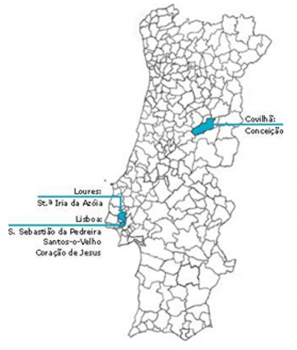

 Public Services
Public Services  Projects
Projects  Electronic Voting
Electronic Voting  2005 Parliamentary Elections
2005 Parliamentary Elections 2005 Parliamentary Elections
- 28/05/2008In a similar manner to the experimental piloting of the 2004 European Elections, the experimental piloting of electronic voting in the 2005 Parliamentary Elections sought to:
- Quantatively measure the impact of the introduction of new technologies in voting on voters, and thus identify the main factors blocking the future implementation of the project;
- Disseminate the potential of presencial electronic voting amongst citizens, by familiarising them with this type of technology;
- Simulate the complete voting procedure using technological platforms, and compare different technologies in terms of their usability and security.
Just as in 2004, electronic voting was not binding, and each voter did so after having voted in the traditional manner.
Three technological solutions were also used which were produced by two multinational suppliers – INDRA and UNISYS – and a national consortium – Multicert/PT Inovação. Each of these companies set up the technological infrastructure in a group of three wards which had different social and demographic profiles (one large-scale urban ward, one semi-urban medium-sized ward and one small rural ward).
The presencial voting component for the experimental piloting involved 5 wards: Conceição (Covilhã); Santa Iria da Azóia (Loures); São Sebastião da Pedreira, Santos-o-Velho and Coração de Jesus (Lisbon).
Map Showing the Location of the Districts containing the Wards involved in the 2005 experimental piloting
Click on the image below to enlarge it | Summary of results per ward
Source: Knowledge Society Agency (UMIC)
Summary of results per ward
- Ward: Conceição (Covilhã)
- Place: Escola do Rodrigo
- No. of votes cast in the pilot: 7.700
- No. of people involved: 8
- Technology: Indra-CPC
- Ward: Coração de Jesus (Lisboa)
- Place: Av. Alexandre Herculano, nº 4
- No. of votes cast in the pilot: 5.123
- No. of people involved: 8
- Technology: Indra-CPC
- Ward: São Sebastião da Pedreira (Lisboa)
- Place: Escola Marquesa de Alorna
- No. of votes cast in the pilot: 7.239
- No. of people involved: 8
- Technology: Unisys-ES&S
- Ward: Santos-o-Velho (Lisboa)
- Place: Junta de Freguesia de Santos-o-Velho
- No. of votes cast in the pilot: 4.590
- No. of people involved: 8
- Technology: Unisys-ES&S
- Ward: Santa Iria da Azóia (Loures)
- Places: Sociedade Recreativa 1º de Agosto Santairiense, Casa da Cultura de Santa Iria da Azóia, Escola Básica nº1, Grupo Desportivo de Pirescoxe, Escola Básica nº2, Atlético de Via Rara AVR, AMUPA
- No. of votes cast in the pilot: 13.966
- No. of people involved: 49
- Technology: Multicert-PT Inovação
This time, given that Parliamentary Elections envisage postal voting for voters registered in international districts – Europe (75,764 voters) and outside Europe (72,395 voters) – there was the possibility of testing, on a non-binding basis, remote electronic voting.
The aims associated with remote electronic voting for this experimental project were:
- Simplifying the electoral process for Portuguese voters registered abroad (making the process swifter and less bureaucratic).
- Using technologies rendering services to Portuguese citizens registered abroad.
- Providing visibility, motivating and strengthening relationships with a community which tends to be forgotten by the Portuguese Public Administration.
- Facilitating the life of Portuguese citizens registered abroad.
- Facilitating and encouraging the exercise of the right to vote for Portuguese citizens registered to vote abroad and their participation in national democracy.
- Developing platforms for electronic democracy to be made available on a widespread basis in the future.
- Refining/testing the uptake of this new way of exercising the right to vote.
- Studying the capacity and usability of this type of system.
The remote voting component was aimed at the electorate registered to vote abroad and used Novabase technology.
The remote voting process took place in the following way:
- The voter received a card at home with a user code (a random alphanumeric code, generated based on crossing uniquely identifiable items).
- After introducing the user code in the web voting platform, the voter once more identified him/herself using his/her electoral number as a security element, as well as a personal random item.
- He/she exercised the right to vote.
- At the moment of confirming the voting choice, a message occurred on the screen asking the person to vote in the traditional manner, and re-emphasising the non-binding nature of the experiment.
- The vote was deposited in a digitally verified database which could only be opened by five authorised members, nominated by each one of the parties with parliamentary representation.
The project was monitored in two ways: The technological component was checked by an independent team of experts who carry out functions at academic and scientific institutions. The level of satisfaction and receptivity of the citizens regarding the electronic voting system was evaluated using a questionnaire designed by UMIC's Observatory for Innovation and Knowledge.
The pilot project was coordinated by The Knowledge Society Agency (UMIC) and by the Technical Secretariat for Electoral Procedures- STAPE, and was supervised by the Portuguese National Election Commission - CNE and the Portuguese Data Protection Authority - CNPD. This time, the project also involved the Ministry for Foreign Affairs, given that the remote voting component of the experiment was undertaken with Portuguese communities registered to vote living abroad.

